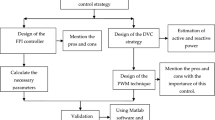Abstract
Due to several factors, wind energy becomes an essential type of electricity generation. The share of this type of energy in the network is becoming increasingly important. The objective of this work is to present the modeling and control strategy of a grid connected wind power generation scheme using a doubly fed induction generator (DFIG) driven by the rotor. This paper is to present the complete modeling and simulation of a wind turbine driven DFIG in the second mode of operating (the wind turbine pitch control is deactivated). It will introduce the vector control, which makes it possible to control independently the active and reactive power exchanged between the stator of the generator and the grid, based on vector control concept (with stator flux or voltage orientation) with classical PI controllers. Various simulation tests are conducted to observe the system behavior and evaluate the performance of the control for some optimization criteria (energy efficiency and the robustness of the control). It is also interesting to play on the quality of electric power by controlling the reactive power exchanged with the grid, which will facilitate making a local correction of power factor.
Similar content being viewed by others
References
Chitti Babu B, Monanty K B, Poongothai C. Performance of Double-Output Induction Generator for Wind Energy Conversion Systems. In: The First IEEE International Conference on Emerging Trends in Engineering and Technology. Nagpur, India, 2008, 933–938
Deepika K K, Srinivasa Rao A. Transient analysis of wind-based doubly-fed induction generator. International Journal of Engineering Research and Applications, 2012, 2(5): 524–527
Mohamed M, Hatoum A, Bouaouiche T. Flicker mitigation in a doubly fed induction generator wind turbine system. Mathematics and Computers in Simulation, 2010, 81(2): 433–445
El-Sattar A A, Saad N H, El-Dein M Z S. Dynamic response of doubly fed induction generator variable speed wind turbine under fault. Electric Power Systems Research, 2008, 78(7): 1240–1246
Yang L, Yang G Y, Xu Z, Dong Z Y, Wong K P, Ma X. Optimal controller design of a wind turbine with doubly fed induction generator for small signal stability enhancement. IET Generation, Transmission & Distribution, 2010, 4(5): 579–597
Wang S H, Chen S H. Blade number effect for a ducted wind turbine. Journal of Mechanical Science and Technology, 2008, 22 (10): 1984–1992
Serhoud H, Benattous D. Simulation of grid connection and maximum power point tracking control of brushless doubly-fed generator in wind power system. Frontiers in Energy, 2013, 7(3): 380–387
Poza J, Oyarbide E, Roye D. New vector control algorithm for brushless doubly-fed machines. In: IEEE 28th Annual Conference of the Industrial Electronics Society, 2002, 2: 1138–1143
Shao S Y, Abdi E, Barati F, McMahon R. Stator-flux-oriented vector for brushless doubly fed induction generator. IEEE Transactions on Industrial Electronics, 2009, 56(10): 4220–4228
Boyette A, Saadate S, Poure P. Direct and indirect control of a doubly fed induction generator wind turbine including a storage unit. In: Proceedings of IEEE 32nd Annual Conference on Industrial Electronics. Paris, France, 2006, 2517–2522
Egea-Alvarez A, Junyent-Ferré A, Gomis-Bellmunt O. Active and reactive power control of grid connected distributed generation systems. Modeling and Control of Sustainable Power Systems Green Energy and Technology, 2012, 47–81
Aktarujjaman M D, Kashem M A, Negnevitsky M, Ledwich G F. Smoothing output power of a doubly fed wind turbine with an energy storage system. In: Proceedings of Australian Universities Power Engineering Conference. Melbourne, Australia, 2006
Kassem A M, Hasaneen K M, Yousef A M. Dynamic modeling and robust power control of DFIG driven by wind turbine at infinite grid. International Journal of Electrical Power and Energy Systems, 2013, 44(1): 375–382
Yamamoto M, Motoyoshi O. Active and reactive power control for doubly-fed wound rotor induction generator. IEEE Transactions on Power Electronics, 1991, 6(4): 624–629
Poitiers F, Bouaouiche T, Machmoum M. Advanced control of a doubly-fed induction generator for wind energy conversion. Electric Power Systems Research, 2009, 79(7): 1085–1096
Author information
Authors and Affiliations
Corresponding author
Rights and permissions
About this article
Cite this article
Tamaarat, A., Benakcha, A. Performance of PI controller for control of active and reactive power in DFIG operating in a grid-connected variable speed wind energy conversion system. Front. Energy 8, 371–378 (2014). https://doi.org/10.1007/s11708-014-0318-6
Received:
Accepted:
Published:
Issue Date:
DOI: https://doi.org/10.1007/s11708-014-0318-6




